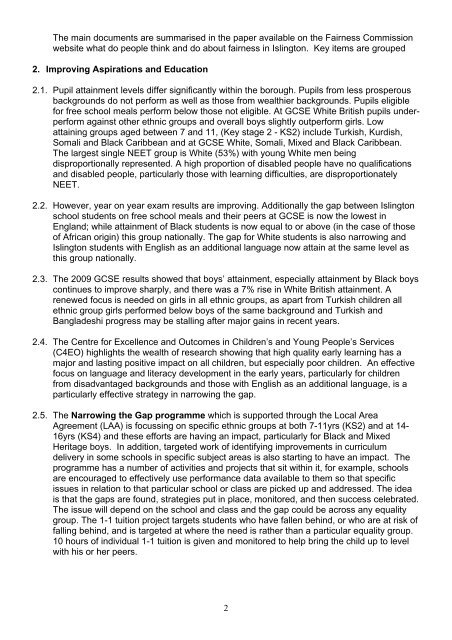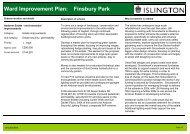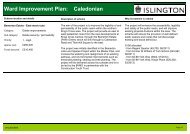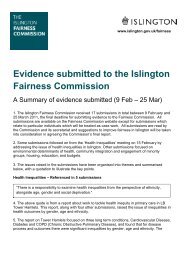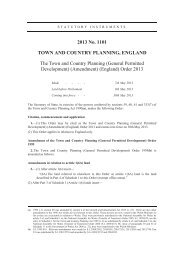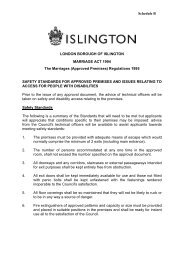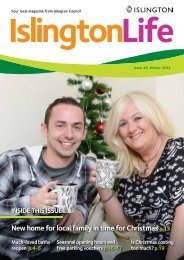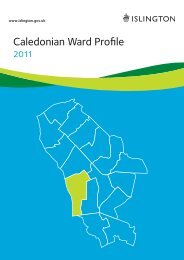Two Islingtons: Understanding the Problem - Islington Council
Two Islingtons: Understanding the Problem - Islington Council
Two Islingtons: Understanding the Problem - Islington Council
You also want an ePaper? Increase the reach of your titles
YUMPU automatically turns print PDFs into web optimized ePapers that Google loves.
The main documents are summarised in <strong>the</strong> paper available on <strong>the</strong> Fairness Commission<br />
website what do people think and do about fairness in <strong>Islington</strong>. Key items are grouped<br />
2. Improving Aspirations and Education<br />
2.1. Pupil attainment levels differ significantly within <strong>the</strong> borough. Pupils from less prosperous<br />
backgrounds do not perform as well as those from wealthier backgrounds. Pupils eligible<br />
for free school meals perform below those not eligible. At GCSE White British pupils underperform<br />
against o<strong>the</strong>r ethnic groups and overall boys slightly outperform girls. Low<br />
attaining groups aged between 7 and 11, (Key stage 2 - KS2) include Turkish, Kurdish,<br />
Somali and Black Caribbean and at GCSE White, Somali, Mixed and Black Caribbean.<br />
The largest single NEET group is White (53%) with young White men being<br />
disproportionally represented. A high proportion of disabled people have no qualifications<br />
and disabled people, particularly those with learning difficulties, are disproportionately<br />
NEET.<br />
2.2. However, year on year exam results are improving. Additionally <strong>the</strong> gap between <strong>Islington</strong><br />
school students on free school meals and <strong>the</strong>ir peers at GCSE is now <strong>the</strong> lowest in<br />
England; while attainment of Black students is now equal to or above (in <strong>the</strong> case of those<br />
of African origin) this group nationally. The gap for White students is also narrowing and<br />
<strong>Islington</strong> students with English as an additional language now attain at <strong>the</strong> same level as<br />
this group nationally.<br />
2.3. The 2009 GCSE results showed that boys’ attainment, especially attainment by Black boys<br />
continues to improve sharply, and <strong>the</strong>re was a 7% rise in White British attainment. A<br />
renewed focus is needed on girls in all ethnic groups, as apart from Turkish children all<br />
ethnic group girls performed below boys of <strong>the</strong> same background and Turkish and<br />
Bangladeshi progress may be stalling after major gains in recent years.<br />
2.4. The Centre for Excellence and Outcomes in Children’s and Young People’s Services<br />
(C4EO) highlights <strong>the</strong> wealth of research showing that high quality early learning has a<br />
major and lasting positive impact on all children, but especially poor children. An effective<br />
focus on language and literacy development in <strong>the</strong> early years, particularly for children<br />
from disadvantaged backgrounds and those with English as an additional language, is a<br />
particularly effective strategy in narrowing <strong>the</strong> gap.<br />
2.5. The Narrowing <strong>the</strong> Gap programme which is supported through <strong>the</strong> Local Area<br />
Agreement (LAA) is focussing on specific ethnic groups at both 7-11yrs (KS2) and at 14-<br />
16yrs (KS4) and <strong>the</strong>se efforts are having an impact, particularly for Black and Mixed<br />
Heritage boys. In addition, targeted work of identifying improvements in curriculum<br />
delivery in some schools in specific subject areas is also starting to have an impact. The<br />
programme has a number of activities and projects that sit within it, for example, schools<br />
are encouraged to effectively use performance data available to <strong>the</strong>m so that specific<br />
issues in relation to that particular school or class are picked up and addressed. The idea<br />
is that <strong>the</strong> gaps are found, strategies put in place, monitored, and <strong>the</strong>n success celebrated.<br />
The issue will depend on <strong>the</strong> school and class and <strong>the</strong> gap could be across any equality<br />
group. The 1-1 tuition project targets students who have fallen behind, or who are at risk of<br />
falling behind, and is targeted at where <strong>the</strong> need is ra<strong>the</strong>r than a particular equality group.<br />
10 hours of individual 1-1 tuition is given and monitored to help bring <strong>the</strong> child up to level<br />
with his or her peers.<br />
2


